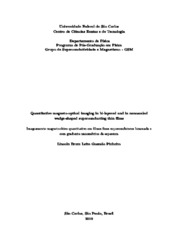| dc.contributor.author | Pinheiro, Lincoln Brum Leite Gusmão | |
| dc.date.accessioned | 2020-07-06T15:05:19Z | |
| dc.date.available | 2020-07-06T15:05:19Z | |
| dc.date.issued | 2019-12-11 | |
| dc.identifier.citation | PINHEIRO, Lincoln Brum Leite Gusmão. Imageamento magneto-ótico quantitativo em filmes finos supercondutores bicamada e com gradiente nanométrico de espessura. 2019. Tese (Doutorado em Física) – Universidade Federal de São Carlos, São Carlos, 2019. Disponível em: https://repositorio.ufscar.br/handle/ufscar/13011. | * |
| dc.identifier.uri | https://repositorio.ufscar.br/handle/ufscar/13011 | |
| dc.description.abstract | Vortex matter in superconductors has been the focus of research of both theoretical and experimental groups around the world.
When developing superconducting devices patterned on thin films one should bear in mind that flux avalanches might occur for some materials at a certain range of applied fields and temperatures. For example, technological applications of NbN thin films may be threatened by the occurrence of magnetic flux avalanches of thermomagnetic origin appearing in a large portion of the superconducting phase. This work deals, in parallel, with two distinct superconducting thin film systems by the technique of quantitative magneto-optical imaging: A bi-layered specimen composed by overlapped layers of Nb and NbN and wedge-shaped superconducting thin films of V3Si and Pb. AC susceptibility and DC magnetometry were used to characterize both the single and multiple-layer films. Magneto-optical imaging reveals interesting features of the dendritic flux avalanches in the bi-layer system, including halo-like patterns around them, and crossing avalanches. The wedge-shaped systems opened a new way to tune the critical current in the film and allowed us to study the resulting changes in the flux penetration patterns along the film. The observation of flux avalanches reported here implies that, as usual, attention to this feature must be given when films with variable thickness and bi-layers are envisaged for possible applications. | eng |
| dc.description.sponsorship | Conselho Nacional de Desenvolvimento Científico e Tecnológico (CNPq) | por |
| dc.language.iso | eng | eng |
| dc.publisher | Universidade Federal de São Carlos | por |
| dc.rights | Attribution-NonCommercial-NoDerivs 3.0 Brazil | * |
| dc.rights.uri | http://creativecommons.org/licenses/by-nc-nd/3.0/br/ | * |
| dc.subject | Supercondutividade | por |
| dc.subject | Avalanches de fluxo | por |
| dc.subject | Bicamada supercondutora | por |
| dc.subject | Filmes finos em forma de cunha | por |
| dc.subject | Evaporação térmica | por |
| dc.subject | Superconductivity | eng |
| dc.subject | Flux avalanches | eng |
| dc.subject | Superconducting bi-layer | eng |
| dc.subject | Wedge-shaped thin films | eng |
| dc.subject | Thermal evaporation | eng |
| dc.title | Imageamento magneto-ótico quantitativo em filmes finos supercondutores bicamada e com gradiente nanométrico de espessura | por |
| dc.title.alternative | Quantitative magneto-optical imaging in bi-layered and in nanoscale wedge-shaped superconducting thin films | eng |
| dc.type | Tese | por |
| dc.contributor.advisor1 | Ortiz, Wilson Aires | |
| dc.contributor.advisor1Lattes | http://lattes.cnpq.br/0241177338066307 | por |
| dc.contributor.advisor-co1 | Motta, Maycon | |
| dc.contributor.advisor-co1Lattes | http://lattes.cnpq.br/8340540626164812 | por |
| dc.description.resumo | A Matéria de Vórtices em supercondutores tem sido foco de pesquisas de grupos teóricos e experimentais em todo o mundo.
Ao desenvolver dispositivos supercondutores litografados usando filmes finos, deve-se ter em mente que avalanches de fluxo podem ocorrer para alguns materiais em uma determinada janela de campos e temperaturas aplicados. Por exemplo, aplicações tecnológicas de filmes finos de NbN podem ser ameaçadas pela ocorrência de avalanches de fluxo magnético de origem termomagnética que aparecem em grande parte da fase supercondutora. Este trabalho trata, paralelamente, de dois sistemas distintos de filmes finos supercondutores analizados pela técnica de imageamento magneto-óptico quantitativo: uma amostra de duas camadas de Nb e NbN e filmes finos supercondutores de V3Si e Pb em forma de cunha. Susceptibilidade AC e magnetometria DC foram utilizadas para caracterizar os filmes. O imagemanto de fluxo magnético revela características interessantes das avalanches de fluxo dendrítico no sistema de duas camadas, incluindo padrões do tipo halo em seu entorno e cruzamento de dendritos. Os sistemas em forma de cunha abriram uma nova maneira de sintonizar a corrente crítica no filme e analisar suas consequências na distribuição de fluxo dentro do filme supercondutor. A observação das avalanches de fluxo nestes dois sistemas implica que deve-se dar atenção às características aqui descritas quando a espessura variável dos filmes ou bicamadas são planejadas para possíveis aplicações. | por |
| dc.publisher.initials | UFSCar | por |
| dc.publisher.program | Programa de Pós-Graduação em Física - PPGF | por |
| dc.subject.cnpq | CIENCIAS EXATAS E DA TERRA::FISICA::FISICA DA MATERIA CONDENSADA::MATERIAIS MAGNETICOS E PROPRIEDADES MAGNETICAS | por |
| dc.subject.cnpq | CIENCIAS EXATAS E DA TERRA::FISICA::FISICA DA MATERIA CONDENSADA::SUPERCONDUTIVIDADE | por |
| dc.subject.cnpq | CIENCIAS EXATAS E DA TERRA::FISICA::FISICA DA MATERIA CONDENSADA::SUPERFICIES E INTERFACES; PELICULAS E FILAMENTOS | por |
| dc.subject.cnpq | CIENCIAS EXATAS E DA TERRA::FISICA::FISICA DA MATERIA CONDENSADA | por |
| dc.description.sponsorshipId | CNPq: 207348/2015-4 | por |
| dc.publisher.address | Câmpus São Carlos | por |
| dc.contributor.authorlattes | http://lattes.cnpq.br/3237585169182345 | por |


